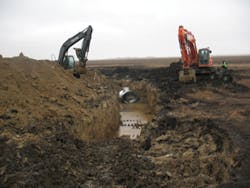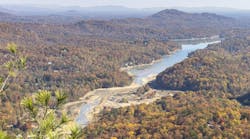Michigan Spillway Flood Control Project
Vast amounts of moisture—both heavy snow and rainfall—have been falling on the flat, rural Red River basin in North Dakota and Minnesota for the past 25 years, says Ben Varnson, chairman of the Nelson County Water Resource District in North Dakota.
Ten inches of rain can fall during the spring thaw, when the snowpack is melting. And because the Red River flows north to Canada, where the channel remains frozen for longer, the water has flooded the basin in the two states.
Michigan Spillway Flood Control Project
Vast amounts of moisture—both heavy snow and rainfall—have been falling on the flat, rural Red River basin in North Dakota and Minnesota for the past 25 years, says Ben Varnson, chairman of the Nelson County Water Resource District in North Dakota. Ten inches of rain can fall during the spring thaw, when the snowpack is melting. And because the Red River flows north to Canada, where the channel remains frozen for longer, the water has flooded the basin in the two states. [text_ad] To make matters worse, 50 square miles of the watershed lie to the north of northern Nelson County, “and when you live at the bottom end of a watershed, you get runoff from the upper reaches watershed as well as from stormwater here onsite,” says Varnson. “There are 48,000 acres in our county,” he adds. “Until the early ’90s, approximately 400 acres were covered with water all year. For the last 15 years, 24,000 acres have been covered all year by water that ranges from two inches deep to 25 feet deep.” The results are flooded basements, impassable roads, and farmland that is underwater all year round in the northern part of Nelson County, including the city of Michigan and portions of Michigan, Rubin, Enterprise, and Sarnia townships. Out of 12 farmsteads in the area, only two are habitable. “We need to get the water off this land and get our folks back up to speed,” says Varnson. “It will take five or more years to accomplish.” Since the late 1990s, landowners, the townships, and county entities all have been working toward a solution. There are already several drainage ditches across county, but the body of water that needs to be drained isn’t connected to any of them. All the land is privately owned. The Michigan Spillway Flood Control Project, a flood damage control initiative, realigned the existing ditches and connected them to one another. The completed channel meanders 8.03 miles across the basin, following the contour of the land. It begins in a field in Enterprise Township and ends at Dry Run Creek, a tributary of the Middle Branch Forest River in Sarnia Township. Once the project is complete, the ditch will divert the water away from the city of Michigan and relieve about 40,000 acres of agricultural and roadway flooding in the county. In doing so, it will recreate more than 60 wetland basins as a secondary benefit. Olson Engineering of Devil’s Lake did the engineering for the project. Because most of the soil is clay, in some pockets 8 feet deep, the majority of the ditch is open design. In other areas, though, especially where the elevations are higher, the soil underneath is a less-stable sandy clay and requires pipe. One roadway also required pipe. “We were looking at all kinds of piping material,” says Varnson. The choice was Aluminized Type ll coated corrugated steel pipe manufactured by TrueNorth Steel, which has its corporate office in Fargo. “They gave a potential lifetime use of 60 to 70 years.” The permitting process was extensive and included local, state, and federal agencies, especially the US Fish and Wildlife Service, the Army Corps of Engineers, and the North Dakota State Water Commission. Because the proposed flood channel was located in an existing 40-year-old drainage system, but with a 5-foot-deeper cut, there were two major concerns. One was that it might have an impact on protected wetlands. Sections of pipe were placed in these areas. The other concern, that invasive species of fish downstream could migrate into the area, will be resolved with the expansion of an existing pump station. The surveying began in 1996. Johnson Excavating in Petersburg began work in late December 2013—not the best time to be in the field in North Dakota, says Keith Fraase, a civil engineer with TrueNorth Steel. “At that time of year, a large part of the ground is frozen, but once they dug below that, they were working in wet ground.” Johnson dug an average of 11 feet, and 22 feet deep on the higher land. Crews placed a total of 5,700 linear feet of 72-inch-diameter (81-inch by 59-inch) arched, aluminized corrugated steel pipe. This pipe has 5-inch by 1-inch corrugation. An advantage of steel pipe is that it can be shipped in long lengths, which reduces freight costs and joint connections. This pipe is 48 feet long. It has access points every 400 feet for ventilation and cleanout. “They had to put it in quickly,” says Fraase. “The bottom of the ditch in those places is water-bearing sandy clay soil.” The soil filled in around the pipes, eliminating the need for aggregate. The amount of cover varies throughout the project between approximately 5 and 15 feet. Along the open parts of the channel, crews used the native clay soil for the 12- to 16-foot bottom width and for the side slopes, which are 3:1 in most places and 4:1 along roadsides. “It’s pretty much flat land, and there isn’t a lot of flow,” says Fraase. “There won’t be flooding in the channel.” The spillway project also enlarges an existing pump station about 4 miles from the beginning of the channel, which was necessary because of the flat topography. The water district is still using temporary pumps until the project is completed. “We may need additional grants to finish the project,” says Varnson. The cost of materials has increased since the original cost share was approved; a route was realigned because of landowner and permitting issues; land costs were higher than anticipated; and there were unanticipated permitting, consultant, and project modifications required to secure the US Army Corps of Engineers 4O4 permit. “Once we got through the permitting process, the project went fairly smoothly,” he says. “The members of the water board have a passion to make a difference. Landowners, local and regional officials, legislators, and the state water commission worked with us to get this accomplished. They all get credited for their help.”To make matters worse, 50 square miles of the watershed lie to the north of northern Nelson County, “and when you live at the bottom end of a watershed, you get runoff from the upper reaches watershed as well as from stormwater here onsite,” says Varnson.
“There are 48,000 acres in our county,” he adds. “Until the early ’90s, approximately 400 acres were covered with water all year. For the last 15 years, 24,000 acres have been covered all year by water that ranges from two inches deep to 25 feet deep.”
The results are flooded basements, impassable roads, and farmland that is underwater all year round in the northern part of Nelson County, including the city of Michigan and portions of Michigan, Rubin, Enterprise, and Sarnia townships. Out of 12 farmsteads in the area, only two are habitable.
“We need to get the water off this land and get our folks back up to speed,” says Varnson. “It will take five or more years to accomplish.”
Since the late 1990s, landowners, the townships, and county entities all have been working toward a solution. There are already several drainage ditches across county, but the body of water that needs to be drained isn’t connected to any of them. All the land is privately owned.
The Michigan Spillway Flood Control Project, a flood damage control initiative, realigned the existing ditches and connected them to one another. The completed channel meanders 8.03 miles across the basin, following the contour of the land. It begins in a field in Enterprise Township and ends at Dry Run Creek, a tributary of the Middle Branch Forest River in Sarnia Township.
Once the project is complete, the ditch will divert the water away from the city of Michigan and relieve about 40,000 acres of agricultural and roadway flooding in the county. In doing so, it will recreate more than 60 wetland basins as a secondary benefit.
Olson Engineering of Devil’s Lake did the engineering for the project. Because most of the soil is clay, in some pockets 8 feet deep, the majority of the ditch is open design. In other areas, though, especially where the elevations are higher, the soil underneath is a less-stable sandy clay and requires pipe. One roadway also required pipe.
“We were looking at all kinds of piping material,” says Varnson. The choice was Aluminized Type ll coated corrugated steel pipe manufactured by TrueNorth Steel, which has its corporate office in Fargo. “They gave a potential lifetime use of 60 to 70 years.”
The permitting process was extensive and included local, state, and federal agencies, especially the US Fish and Wildlife Service, the Army Corps of Engineers, and the North Dakota State Water Commission.
Because the proposed flood channel was located in an existing 40-year-old drainage system, but with a 5-foot-deeper cut, there were two major concerns. One was that it might have an impact on protected wetlands. Sections of pipe were placed in these areas. The other concern, that invasive species of fish downstream could migrate into the area, will be resolved with the expansion of an existing pump station.
The surveying began in 1996. Johnson Excavating in Petersburg began work in late December 2013—not the best time to be in the field in North Dakota, says Keith Fraase, a civil engineer with TrueNorth Steel. “At that time of year, a large part of the ground is frozen, but once they dug below that, they were working in wet ground.”
Johnson dug an average of 11 feet, and 22 feet deep on the higher land. Crews placed a total of 5,700 linear feet of 72-inch-diameter (81-inch by 59-inch) arched, aluminized corrugated steel pipe. This pipe has 5-inch by 1-inch corrugation.
An advantage of steel pipe is that it can be shipped in long lengths, which reduces freight costs and joint connections. This pipe is 48 feet long. It has access points every 400 feet for ventilation and cleanout.
“They had to put it in quickly,” says Fraase. “The bottom of the ditch in those places is water-bearing sandy clay soil.”
The soil filled in around the pipes, eliminating the need for aggregate. The amount of cover varies throughout the project between approximately 5 and 15 feet.
Along the open parts of the channel, crews used the native clay soil for the 12- to 16-foot bottom width and for the side slopes, which are 3:1 in most places and 4:1 along roadsides.
“It’s pretty much flat land, and there isn’t a lot of flow,” says Fraase. “There won’t be flooding in the channel.”
The spillway project also enlarges an existing pump station about 4 miles from the beginning of the channel, which was necessary because of the flat topography. The water district is still using temporary pumps until the project is completed.
“We may need additional grants to finish the project,” says Varnson. The cost of materials has increased since the original cost share was approved; a route was realigned because of landowner and permitting issues; land costs were higher than anticipated; and there were unanticipated permitting, consultant, and project modifications required to secure the US Army Corps of Engineers 4O4 permit.
“Once we got through the permitting process, the project went fairly smoothly,” he says. “The members of the water board have a passion to make a difference. Landowners, local and regional officials, legislators, and the state water commission worked with us to get this accomplished. They all get credited for their help.”


